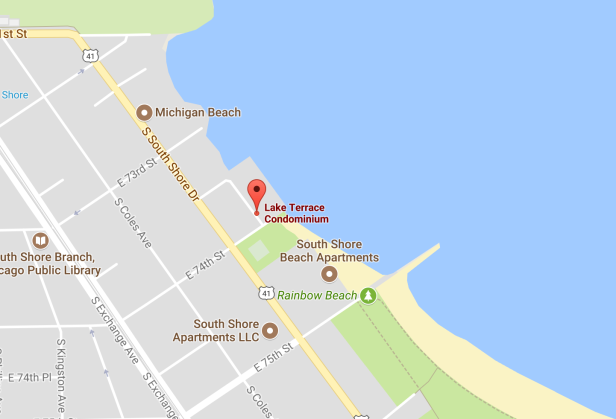In Chicago, there is a stretch of private land more rare than owning your own beach but it’s almost impossible to see. Why? It’s underwater, which means its owners lay claim to a piece of Lake Michigan. The land is only 300 feet from shore just south of the South Shore Cultural Center. It looks to be the only private property in Cook County that is completely underwater.
Videos by Rare
The back story of the land, which has its own mailing address and Cook County PIN numbers, was anchored underwater dates back to exactly a century after it was covered by a “hurricane” according to one newspaper. It continues to remain private due to the failure of two acts of the Illinois Legislature and one headstrong developer.
Back in 1917 the stretch of the shoreline between the South Shore Cultural Center and Rainbow Beach was a neat row of lakefront cottages along two private beaches, Manhattan and Nichols beaches. But on Nov. 1, 1917, a huge storm hit the lakefront. The storm was so horrific that according to the Chicago Herald it was a “hurricane” and reported that in 36 hours it caused upwards of $100,000 dollars in damage or approximately $2 million adjusted for inflation.
A meteorologist, Matt Friedlein, with the National Weather Service said the storm occurred before detailed records existed of such events but said a hurricane would have been impossible. However, fall storms from the eastern seaboard can bring tropical storm winds of upwards of 60 miles per hour, he said, which easily would have been enough to knock over trees and rip a roof off a house.
“Those winds build big waves,” said Friedlein. So big that homes were quite literally washed away. Frank Sweeney who once lived at 7650 S. Lake Park Avenue from 1914 until 1918, when his house was condemned. Sweeny testified in 1954 at a court case that the shoreline up to his doorstep literally disappeared into the lake during the two-day storm. The storm “tore away the property there, about 150 feet of the shoreline,” said Sweeny.
“The people were afraid that night — I received a good number of telephone calls asking me to give up, not to live in the house, that I would be out in the lake,” Sweeney said. “I did stay there in the house that night.”
The Herald’s front page showed that waves had literally pushed a pile of broken concrete onto Sweeny’s doorstep at Lake Park Avenue which was originally known as Lake Avenue and can be seen on maps dating to 1888.
Just east of Lake Park Avenue, there are two privately-owned beaches that stretch from 71st to 79th streets that also went underwater. The current owner purchased the 29,250-square-foot property in 2010 for an undisclosed amount in a tax sale, according to Cook County Recorder of Deeds records. The owner who lives on the lakefront near the land that is submerged land declined to be named and also noted she is not sure if it’s worth much money but it is valuable to her.
“When you have a view, you want to protect what would block your view,” she said.
She claims she was unaware of the history of the property, but after several decades living on the lake, she has seen fall storms where crashing waves send spray from the lake three stories in the air – waves that can literally move stone.
“We would see these cobblestones, that the lake brings you in a storm, they would just be rolling across the lawn,” said the owner. The owner pays close to $290 a year in property taxes to hold onto the space.
“You just get a tax bill, I don’t know if they even know it’s underwater,” she said.
She says she has no intention to build on the underwater property. There is a second shorter stretch of the underwater property was likely part of Nicholas Beach that is owned by Clarence Walsh of Jacksonville, Fla., according to property records. The two properties are the only two in the city known to be completely cut off from land.
RELATED: An emotional Jennifer Lopez reveals her family’s pain after the hurricane in Puerto Rico
If it wasn’t for developer Henry Dubin of Dubin and Dubin Architects, no one would own any of the underwater land – specifically the $5.5 million high-rise condo building Dubin wanted to build that was later jut out 140 feet into the lake in 1954.
Lake Terrace, 7337 S. South Shore Drive, sits on the boundary of where Lake Park Avenue once was. Dubin’s attorney had to convince a judge that he could still purchase the land close to 40 years after it had gone underwater.

In most situations, if the lake erodes a section of the lakeshore – whatever goes underwater becomes the property of the state. The Illinois Legislature had in 1903 and 1931 ordered any remaining claims to the underwater property in South Shore to be given over to the Chicago Park District.
Jacob Grossman, Dubin’s attorney, was able to successfully argue that a storm is not the same as natural erosion and the owner always have a right to rebuild – even now. When the judge agreed, Dubin was able to build his building literally into Lake Michigan, which now laps at the metal base of the property.
[anvplayer video=”4171487″]



